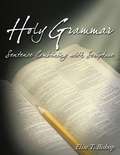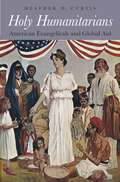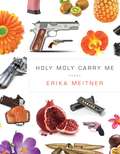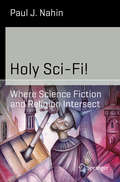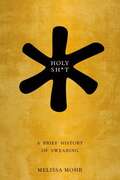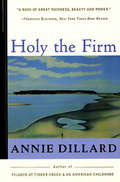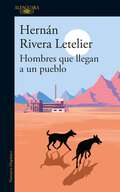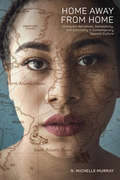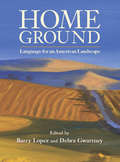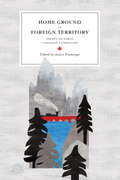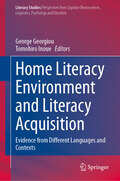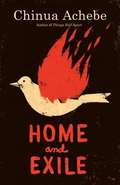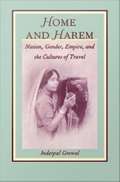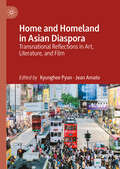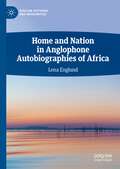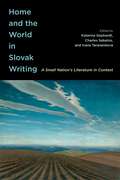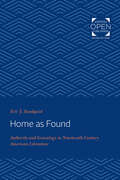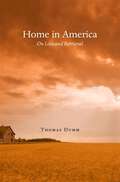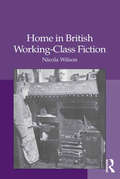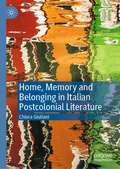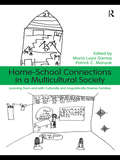- Table View
- List View
Holy Grammar: Sentence Combining with Scripture
by Elise BishopA workbook like no other, Holy Grammar teaches basic grammar skills using examples and exercises only from Scripture. Students apply sentence combining techniques to over 200 Bible verses to improve the complexity, correctness, and variety of sentences in their own writing. Designed for use in a composition class, Holy Grammar was written by a secondary and college composition and grammar instructor with over 35 years of experience in the classroom. In a challenging way that relies more on intrinsic knowledge of language than memorization of rules, the exercises provide students with the practice they need to produce (and correctly punctuate) a variety of sentence types. The teaching tips included demonstrate flexible methods for teachers who want to incorporate the lessons into their classes. With the Bible itself serving as the answer key, students have the ability to check their own work. A grammar review section examines parts of speech, clauses and phrases, and basic sentence types and patterns. The skills presented in this workbook lay the foundation for more advanced grammar study.
Holy Humanitarians: American Evangelicals and Global Aid
by Heather D. CurtisOn May 10, 1900, an enthusiastic Brooklyn crowd bid farewell to the Quito. The ship sailed for famine-stricken Bombay, carrying both tangible relief—thousands of tons of corn and seeds—and “a tender message of love and sympathy from God’s children on this side of the globe to those on the other.” The Quito may never have gotten under way without support from the era’s most influential religious newspaper, the Christian Herald, which urged its American readers to alleviate poverty and suffering abroad and at home. In Holy Humanitarians, Heather D. Curtis argues that evangelical media campaigns transformed how Americans responded to domestic crises and foreign disasters during a pivotal period for the nation. Through graphic reporting and the emerging medium of photography, evangelical publishers fostered a tremendously popular movement of faith-based aid that rivaled the achievements of competing agencies like the American Red Cross. By maintaining that the United States was divinely ordained to help the world’s oppressed and needy, the Christian Herald linked humanitarian assistance with American nationalism at a time when the country was stepping onto the global stage. Social reform, missionary activity, disaster relief, and economic and military expansion could all be understood as integral features of Christian charity. Drawing on rigorous archival research, Curtis lays bare the theological motivations, social forces, cultural assumptions, business calculations, and political dynamics that shaped America’s ambivalent embrace of evangelical philanthropy. In the process she uncovers the seeds of today’s heated debates over the politics of poverty relief and international aid.
Holy Moly Carry Me (American Poets Continuum #166)
by Erika MeitnerWinner of the 2018 National Jewish Book Award for Poetry Erika Meitner’s fifth collection of poetry plumbs human resilience and grit in the face of disaster, loss, and uncertainty. These narrative poems take readers into the heart of southern Appalachia—its highways and strip malls and gun culture, its fragility and danger—as the speaker wrestles with what it means to be the only Jewish family in an Evangelical neighborhood and the anxieties of raising one white son and one black son amidst racial tensions and school lockdown drills. With a firm hand on the pulse of the uncertainty at the heart of 21st century America and a refusal to settle for easy answers, Meitner’s poems embrace life in an increasingly fractured society and never stop asking what it means to love our neighbor as ourselves.
Holy Sci-Fi!
by Paul J. NahinCan a computer have a soul? Are religion and science mutually exclusive? Is there really such a thing as free will? If you could time travel to visit Jesus, would you (and should you)? For hundreds of years, philosophers, scientists and science fiction writers have pondered these questions and many more. In Holy Sci-Fi!, popular writer Paul Nahin explores the fertile and sometimes uneasy relationship between science fiction and religion. With a scope spanning the history of religion, philosophy and literature, Nahin follows religious themes in science fiction from Feynman to Foucault and from Asimov to Aristotle. An intriguing journey through popular and well-loved books and stories, Holy Sci-Fi! shows how sci-fi has informed humanity's attitudes towards our faiths, our future and ourselves.
Holy Sh*t: A Brief History of Swearing
by Melissa MohrDetermining what is obscene is a timeless preoccupation, nearly as timeless as the search for words that adequately express a relationship with the divine. As Melissa Mohr shows in this imaginative and illuminating tour through linguistic history, those preoccupations are not separate. "Swearing" is what we do when we forge a bond with a higher authority, as when we tell the truth and nothing but the truth; it is also what we do to break that bond. In both cases, certain words are endowed with the power to shock or to awe. Obscenities tend toward the earthy and generally remind us that we have bodies. Oaths are lifted to heaven and serve to remind us that we have souls. Holy Sh*t brilliantly and entertainingly investigates these two kinds of swearing--obscenities and oaths--from ancient Rome and the Bible to the present, uncovering the history of sacred and profane language in English through the ages. It is a journey with a number of surprises. Obscenities in ancient Rome were remarkably similar to our own; George Carlin would have felt completely at home. With the rise of the Church came a new sense of how language should be used, or not--and the difference was often a matter of life and death. Holy Sh*t tracks the advancement of civility and corresponding censorship of language in the eighteenth century; considers the rise of racial slurs after World War II; examines the physiological effects of swearing (increased heart rate and greater pain tolerance); and answers a question that preoccupies the FCC, the U.S. Senate, and anyone who has lately visited a junior high school: are we swearing more now than people did in the past? A gem of lexicography and cultural history, Holy Sh*t is a serious exploration of linguistic totem and taboo. It charts the way swearing has changed over the centuries, and considers the cultural concerns that gave way to those changes. By looking at the words that have expressed our deepest emotions, high and low, Holy Sh*t reveals the shifting relationship between the divine and the dirty. MELISSA MOHR has recently been dividing her time between writing this book about swearing, and hiding it from her kids. She received a Ph.D. in English literature from Stanford University, specializing in Medieval and Renaissance literature. She lives in Somerville, Massachusetts.
Holy the Firm
by Annie DillardIn 1975 Annie Dillard took up residence on an island in Puget Sound in a wooded room furnished with "one enormous window, one cat, one spider and one person." For the next two years she asked herself questions about time, reality, sacrifice death, and the will of God. In Holy the Firm she writes about a moth consumed in a candle flame, about a seven-year-old girl burned in an airplane accident, about a baptism on a cold beach. But behind the moving curtain of what she calls "the hard things -- rock mountain and salt sea," she sees, sometimes far off and sometimes as close by as a veil or air, the power play of holy fire. This is a profound book about the natural world -- both its beauty and its cruelty -- the Pulitzer Prize-winning Dillard knows so well.
Homage to Robert Penn Warren: A Collection of Critical Essays
by Frank GrazianoHighly supportive essays.
Hombres que llegan a un pueblo
by Hernán Rivera LetelierTres novelas breves del más clásico estilo de Rivera Letelier, hombres perdidos que llegan a la pampa salitrera a descubrir una parte de sí mismos y del mundo que se perdió en ellas. En estas breves y entrañables tres novelas breves, Hernán Rivera Letelier vuelve a uno de sus temas con que más maestría ha escrito, el del perdido mundo salitrero. Un violinista, un fotógrafo y un embaucador llegan a tres oficinas salitreras y descubrirán en ellas no solo un mundo en donde el abuso y la explotación obrera era pan de cada día, sino también la violencia, el amor, la amistad. Un mundo con ciertos aires fantasmagórico que Rivera Letelier revela a sus lectores con el sello que lo ha hecho famoso en el mundo entero.
Home Away from Home: Immigrant Narratives, Domesticity, and Coloniality in Contemporary Spanish Culture (North Carolina Studies in the Romance Languages and Literatures #315)
by N. Michelle MurrayHome Away from Home: Immigrant Narratives, Domesticity, and Coloniality in Contemporary Spanish Culture examines ideological, emotional, economic, and cultural phenomena brought about by migration through readings of works of literature and film featuring domestic workers. In the past thirty years, Spain has experienced a massive increase in immigration. Since the 1990s, immigrants have been increasingly female, as bilateral trade agreements, migration quotas, and immigration policies between Spain and its former colonies (including the Dominican Republic, Ecuador, Equatorial Guinea, and the Philippines) have created jobs for foreign women in the domestic service sector. These migrations reveal that colonial histories continue to be structuring elements of Spanish national culture, even in a democratic era in which its former colonies are now independent. Migration has also transformed the demographic composition of Spain and has created complex new social relations around the axes of gender, race, and nationality. Representations of migrant domestic workers provide critical responses to immigration and its feminization, alongside profound engagements with how the Spanish nation has changed since the end of the Franco era in 1975. Throughout Home Away from Home, readings of works of literature and film show that texts concerning the transnational nature of domestic work uniquely provide a nuanced account of the cultural shifts occurring in late twentieth- through twenty-first-century Spain.
Home Ground
by Debra Gwartney Barry LopezPublished to great acclaim in 2006, the hardcover edition of Home Ground: Language for an American Landscape met with outstanding reviews and strong sales, going into three printings. A language-lover's dream, Home Ground revitalized a descriptive language for the American landscape by combining geography, literature, and folklore in one volume. Now in paperback, this visionary reference is available to an entire new segment of readers. Home Ground brings together 45 poets and writers to create more than 850 original definitions for words that describe our lands and waters. The writers draw from careful research and their own distinctive stylistic, personal, and regional diversity to portray in bright, precise prose the striking complexity of the landscapes we inhabit. Home Ground includes 100 black-and-white line drawings by Molly O'Halloran and an introductory essay by Barry Lopez.
Home Ground
by Debra Gwartney Barry LopezPublished to great acclaim in 2006, the hardcover edition of Home Ground: Language for an American Landscape met with outstanding reviews and strong sales, going into three printings. A language-lover's dream, Home Ground revitalized a descriptive language for the American landscape by combining geography, literature, and folklore in one volume. Now in paperback, this visionary reference is available to an entire new segment of readers. Home Ground brings together 45 poets and writers to create more than 850 original definitions for words that describe our lands and waters. The writers draw from careful research and their own distinctive stylistic, personal, and regional diversity to portray in bright, precise prose the striking complexity of the landscapes we inhabit. Home Ground includes 100 black-and-white line drawings by Molly O'Halloran and an introductory essay by Barry Lopez.
Home Ground and Foreign Territory: Essays on Early Canadian Literature (Reappraisals: Canadian Writers)
by Janice FiamengoHome Ground and Foreign Territory is an original collection of essays on early Canadian literature in English. Aiming to be both provocative and scholarly, it encompasses a variety of (sometimes opposing) perspectives, subjects, and methods, with the aim of reassessing the field, unearthing neglected texts, and proposing new approaches to canonical authors. Renowned experts in early Canadian literary studies, including D.M.R. Bentley, Mary Jane Edwards, and Carole Gerson, join emerging scholars in a collection distinguished by its clarity of argument and breadth of reference. Together, the essays offer bold and informative contributions to the study of this dynamic literature. Home Ground and Foreign Territory reaches out far beyond the scope of early Canadian literature. Its multi-disciplinary approach innovates literal studies and appeals to literature specialists and general readership alike.
Home Literacy Environment and Literacy Acquisition: Evidence from Different Languages and Contexts (Literacy Studies #26)
by George Georgiou Tomohiro InoueThis book provides a comprehensive and up-to-date overview of the literature on home literacy environment and its association with literacy skills in different languages and contexts. Home literacy environment (HLE), an umbrella term that encompasses various activities parents engage in with their children, has been studied extensively by psychologists, linguists, behavioral geneticists, and educators. However, no systematic effort has been put into synthesizing this growing body of research in a coherent manner, making it difficult for researchers and various stakeholders to understand the key points of past research while keeping up with the latest research findings. To address this need, the first part of the book provides an overview of the current literature on conceptualizations of HLE, covering prominent theoretical models, the measurement of HLE, the potential extension and generalizability of models across contexts, the intersections between home learning environment in literacy, numeracy, and other domains, and the genetic and environmental etiology of literacy development The second section of the book hosts a wide variety of studies from all over the world, conducted in English-speaking countries (UK, U.S., Canada), Finland, Greece, Turkey, China, Japan, the Philippines and other Southeast Asian countries, and Chile and other Latin American and Caribbean countries, while it includes chapters with both typically-developing children and children at familial risk of dyslexia. The third section of this book offers a comprehensive collection of chapters on intervention studies examining the role of family literacy programs, dialogic reading, and onscreen digital access. Together, the 22 chapters of this book elucidate the complex nature of HLE and provide future research directions and instructional recommendations on how parents and policymakers can improve home literacy practices around the world. As such, this book is valuable for researchers, educators, and other professionals, and the readership ranges from graduate students and scholars to parents and policymakers.
Home and Exile
by Chinua AchebeMore personally revealing than anything Achebe has written, "Home and Exile"--the great Nigerian novelist's first book in more than ten years--is a major statement on the importance of stories as real sources of power, especially for those whose stories have traditionally been told by outsiders. In three elegant essays, Achebe seeks to rescue African culture from narratives written about it by Europeans. Looking through the prism of his experiences as a student in English schools in Nigeria, he provides devastating examples of European cultural imperialism. He examines the impact that his novel "Things Fall Apart" had on efforts to reclaim Africa's story. And he argues for the importance of writing and living the African experience because, he believes, Africa needs stories told by Africans.
Home and Harem: Nation, Gender, Empire, and the Cultures of Travel
by Inderpal GrewalMoving across academic disciplines, geographical boundaries, and literary genres, Home and Harem examines how travel shaped ideas about culture and nation in nineteenth-century imperialist England and colonial India. Inderpal Grewal's study of the narratives and discourses of travel reveals the ways in which the colonial encounter created linked yet distinct constructs of nation and gender and explores the impact of this encounter on both English and Indian men and women. Reworking colonial discourse studies to include both sides of the colonial divide, this work is also the first to discuss Indian women traveling West as well as English women touring the East. In her look at England, Grewal draws on nineteenth-century aesthetics, landscape art, and debates about women's suffrage and working-class education to show how all social classes, not only the privileged, were educated and influenced by imperialist travel narratives. By examining diverse forms of Indian travel to the West and its colonies and focusing on forms of modernity offered by colonial notions of travel, she explores how Indian men and women adopted and appropriated aspects of European travel discourse, particularly the set of oppositions between self and other, East and West, home and abroad. Rather than being simply comparative, Home and Harem is a transnational cultural study of the interaction of ideas between two cultures. Addressing theoretical and methodological developments across a wide range of fields, this highly interdisciplinary work will interest scholars in the fields of postcolonial and cultural studies, feminist studies, English literature, South Asian studies, and comparative literature.
Home and Homeland in Asian Diaspora: Transnational Reflections in Art, Literature, and Film
by Kyunghee Pyun Jean AmatoWhile many of us may strive to locate a sense of identity and belonging expressed via a home or ancestral homeland; today, however, this connection is no longer, if it ever was, a straightforward identification. This collection aims at mapping narratives or artwork of home/homeland that present shared, private, multifaceted, and often contested experiences of place, especially in the context of today’s migrations and upheavals, along with alarming degrees of increased nativism, racism, and anti-Asian violence. This volume includes papers by artists, filmmakers, and comparative scholars from diverse disciplines of literature, cinema, art history, cultural studies, and gender studies. Our goal is to help literary and art historian scholars in Asian diaspora studies, better decolonize and open up traditional research methodologies, curricula, and pedagogies.
Home and Nation in Anglophone Autobiographies of Africa (African Histories and Modernities)
by Lena EnglundThis book looks at contemporary autobiographical works by writers with African backgrounds in relation to the idea of ‘place’. It examines eight authors’ works – Helen Cooper’s The House at Sugar Beach, Sisonke Msimang’s Always Another Country, Leila Ahmed’s A Border Passage, Noo Saro-Wiwa’s Looking for Transwonderland, Douglas Rogers’s The Last Resort, Elamin Abdelmahmoud’s Son of Elsewhere, Clemantine Wamariya and Elizabeth Weil’s The Girl Who Smiled Beads and Aminatta Forna’s autobiographical writing – to argue that place is particularly central to personal narrative in texts whose authors have migrated multiple times. Spanning Liberia, Nigeria, Sierra Leone, Egypt, Rwanda, Zambia, and Zimbabwe, this book interrogates the label ‘African’ writing which has been criticized for ignoring local contexts. It demonstrates how in their works these writers seek to reconnect with a bygone ‘Africa’, often after complex experiences of political upheavals and personal loss. The chapters also provide in-depth analyses of key concepts related to place and autobiography: place and privilege, place and trauma, and the relationship between place and nation.
Home and Nation in British Literature from the English to the French Revolutions
by Cousins, A. D. and Payne, Geoffrey A. d. Cousins Geoffrey PayneIn a world of conflicting nationalist claims, mass displacements and asylum-seeking, a great many people are looking for 'home' or struggling to establish the 'nation'. These were also important preoccupations between the English and the French revolutions: a period when Britain was first at war within itself, then achieved a confident if precarious equilibrium, and finally seemed to have come once more to the edge of overthrow. In the century and a half between revolution experienced and revolution observed, the impulse to identify or implicitly appropriate home and nation was elemental to British literature. This wide-ranging study by international scholars provides an innovative and thorough account of writings that vigorously contested notions and images of the nation and of private domestic space within it, tracing the larger patterns of debate, while at the same time exploring how particular writers situated themselves within it and gave it shape.
Home and the World in Slovak Writing: A Small Nation’s Literature in Context
by Katarina Gephardt, Charles Sabatos, and Ivana TaranenkováLiteratures of small nations represent a minuscule portion of the global literary marketplace, where books written in English outnumber translated works. The struggle for visibility in relation to dominant languages and cultures is not new in Slovakia, a nation of five million whose literary history has been shaped by the influence of more widely spoken languages including Hungarian, Czech, and Russian.Home and the World in Slovak Writing brings Slovak literature out of this isolation to tell the story of how a nation’s literature can survive and thrive despite a small domestic audience and relatively limited circulation in English translation. The book demonstrates how historic events such as the post-Stalin Thaw, the Prague Spring, and the Velvet Revolution moulded the Slovak canon and situates contemporary Slovak literature in broader regional and global contexts. Through case studies of the transformations and adaptations of Slovak literature, contributors examine the changing social roles of writers, the tensions between tradition and innovation, and the dynamic interactions between influences from the outside world and domestic sources of inspiration.Home and the World in Slovak Writing maps the relationship between geopolitical destiny and literary production at a critical moment. As relations between the East and the West are destabilized by war, the question of cultural identity has again become a matter of national survival in Central Europe.
Home as Found: Authority and Genealogy in Nineteenth-Century American Literature
by Eric J. SundquistOriginally published in 1979. Eric Sundquist takes four representative writers—James Fenimore Cooper, Henry David Thoreau, Nathaniel Hawthorne, and Herman Melville—and considers the way in which each grapples with the crucial issues of genealogy and authority in his works. From all four a common pattern emerges: the desire to revolt against the past is countered by the need to invoke or even repeat it. Sundquist's approach to the texts is psychoanalytic, but he does not attempt a clinical dissection of each writer; rather, he determines how personal crisis became material for engaging with larger questions of social and literary crisis.
Home in America: On Loss and Retrieval
by Thomas DummAmericans encounter their homes in ways comforting and haunting: as an imagined refuge or a place of mastery and domination, a destination or a place to escape. Drawing on literature, personal experience, and the histories of slavery, incarceration, and homesteading, Thomas Dumm offers a meditation on the richness and poverty of the idea of home.
Home in British Working-Class Fiction
by Nicola WilsonHome in British Working-Class Fiction offers a fresh take on British working-class writing that turns away from a masculinist, work-based understanding of class in favour of home, gender, domestic labour and the family kitchen. As Nicola Wilson shows, the history of the British working classes has often been written from the outside, with observers looking into the world of the inhabitants. Here Wilson engages with the long cultural history of this gaze and asks how ’home’ is represented in the writing of authors who come from a working-class background. Her book explores the depiction of home as a key emotional and material site in working-class writing from the Edwardian period through to the early 1990s. Wilson presents new readings of classic texts, including The Ragged Trousered Philanthropists, Love on the Dole and Saturday Night and Sunday Morning, analyzing them alongside works by authors including James Hanley, Walter Brierley, Lewis Grassic Gibbon, Buchi Emecheta, Pat Barker, James Kelman and the rediscovered ’ex-mill girl novelist’ Ethel Carnie Holdsworth. Wilson's broad understanding of working-class writing allows her to incorporate figures typically ignored in this context, as she demonstrates the importance of home's role in the making and expression of class feeling and identity.
Home on the Stage
by Nicholas GreneAs a serious drama set in an ordinary middle-class home, Ibsen's A Doll's House established a new politics of the interior that was to have a lasting impact upon twentieth-century drama. In this innovative study, Nicholas Grene traces the changing forms of the home on the stage through nine of the greatest of modern plays and playwrights. From Chekhov's The Cherry Orchard through to Williams's A Streetcar Named Desire, domestic spaces and personal crises have been employed to express wider social conditions and themes of class, gender and family. In the later twentieth century and beyond, the most radically experimental dramatists created their own challenging theatrical interiors, including Beckett in Endgame, Pinter in The Homecoming and Parks in Topdog/Underdog. Grene analyses the full significance of these versions of domestic spaces to offer fresh insights into the portrayal of the naturalistic environment in modern drama.
Home, Memory and Belonging in Italian Postcolonial Literature
by Chiara GiulianiThis book examines the meaning of home through the investigation of a series of public and private spaces recurrent in Italian postcolonial literature. The chapters, by respectively considering Termini train station in Rome, phone centres, the condominium, and the private spaces of the bathroom and the bedroom, investigate how migrant characters inhabit those places and turn them into familiar spaces of belonging. Home, Memory and Belonging in Italian Postcolonial Literature suggests “home spaces” as a possible lens to examine these specific places and a series of practices enacted by their inhabitants in order to feel at home. Drawing on a wide array of sources, this book focuses on the role played by memory in creating transnational connections between present and past locations and on how these connections shape migrants’ sense of self and migrants’ identity.
Home-School Connections in a Multicultural Society: Learning From and With Culturally and Linguistically Diverse Families (Language, Culture, and Teaching Series)
by Maria Luiza Dantas Patrick C. ManyakEducators everywhere confront critical issues related to families, schooling, and teaching in diverse settings. Directly addressing this reality, Home-School Connections in a Multicultural Society shows pre-service and practicing teachers how to recognize and build on the rich resources for enhancing school learning that exist within culturally and linguistically diverse families. Combining engaging cases and relevant key concepts with thought-provoking pedagogical features, this valuable resource for educators at all levels: Provides detailed portraits of diverse families that highlight their unique cultural practices related to schooling and the challenges that their children face in school settings Introduces key sociocultural and ethnographic concepts, in ways that are both accessible and challenging, and applies these concepts as lenses through which to examine the portraits Shows how teachers and researchers have worked with diverse families to build positive relationships and develop learning activities that incorporate children’s unique experiences and resources Disrupting deficit assumptions about the experiences and knowledge that culturally and linguistically diverse children acquire in their homes and communities, this book engages readers in grappling deeply and personally with the chapters’ meanings and implications, and in envisioning their own practical ways to learn from and with families and children.
